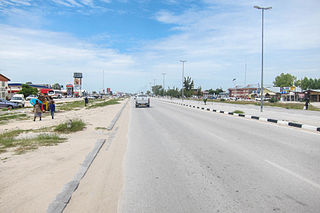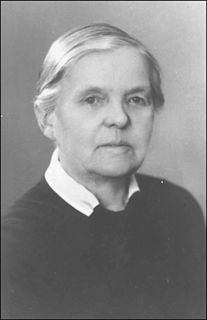
Ondangwa is a town of 23,000 inhabitants in the Oshana Region of northern Namibia, bordering Oshikoto Region. Ondangwa was first established as a mission station of the Finnish Missionary Society in 1890. In 1914 it became a local seat of government.
Okahao is a town in the Omusati Region of northern Namibia and the district capital of the Okahao electoral constituency. It is situated in the Ongandjera tribal area 73 kilometres (45 mi) west of Oshakati on the main road MR123. It is a former mission station of the Finnish Missionary Society.
Tsandi is a village in the Omusati Region of northern Namibia and the district capital of the Tsandi electoral constituency. It is a former mission station of the Finnish Missionary Society. It is situated on the main road MR123.

Martti (Martin) Rautanen was the pioneer of the Finnish Mission in Ovamboland, South West Africa.
Karl Emil Liljeblad was a Finnish pastor, vicar, missionary and educator, and during his final years, a researcher in Folkloristics.

The Finnish Evangelical Lutheran Mission is a Lutheran missionary society formed on January 19, 1859, in Helsinki, Finland. It is one of seven organisations of the Evangelical Lutheran Church of Finland (ELCF) that conduct missionary work. Its first deployments outside Finland were made to Ovamboland, an area that today is cut by the Angola-Namibian border.
Nakayale, also known as Nakayale Keengulu is a village in northern Namibia near Outapi in Omusati Region situated 86km northwest of Oshakati and 4km from Outapi. It is in Anamulenge Constituency.

Jooseppi Mustakallio, originally Josef Schwartzberg, was a Finnish minister and the fourth mission director of the Finnish Missionary Society, after Akseli Hirn. He was also a poet and a lyricist. His best known poem is called “Evening Song”.

Selma Rainio was a Finnish missionary with the Finnish Missionary Society, the first Finnish medical missionary, who founded the Onandjokwe Hospital in the Ondonga tribal area in Ovamboland. She also worked in the Engela Hospital. In Ovamboland, she was known as Kuku Selma ‘grandmother Selma’.
Engela is an Ovambo settlement in the Ohangwena Region in northern Namibia. Formerly situated in the Oukwanyama area it is since 2004 part of the town Helao Nafidi, although it still maintained its own village council until the 2015 local authority election. It is one of the more important establishments of the Evangelical Lutheran Church in Namibia (ELCIN) in the area. It started as a mission station of the Finnish Missionary Society. Today, it is the centre of the Engela Constituency.
Paulus Hamutenya was one of the first seven Ovambos to be ordained a pastor in Oniipa, Ovamboland, in 1925 by the director of the Finnish Missionary Society, Matti Tarkkanen.

Humbe is a town and commune in the municipality of Ombadja, province of Cunene, Angola.
Sakeus Iihuhua was one of the first seven Ovambo pastors, whom the director of the Finnish Missionary Society, Matti Tarkkanen ordained into priesthood in Oniipa, Ovamboland, on 27 September 1925, with a permission granted by the Bishop of Tampere, Jaakko Gummerus. His brother Obadja Iihuhua was also ordained at the same time.
Obadja Iihuhua was one of the first seven Ovambo pastors, whom the director of the Finnish Missionary Society, Matti Tarkkanen ordained into priesthood in Oniipa, Ovamboland, on 27 September 1925, with a permission granted by the Bishop of Tampere, Jaakko Gummerus. His brother Sakeus Iihuhua was also ordained at the same time.
Gideon Iitula was one of the first seven Ovambo pastors, whom the director of the Finnish Missionary Society, Matti Tarkkanen ordained into priesthood in Oniipa, Ovamboland, on 27 September 1925, with a permission granted by the Bishop of Tampere, Jaakko Gummerus.
Juuso Ngaikukwete was one of the first seven Ovambo pastors, whom the director of the Finnish Missionary Society, Matti Tarkkanen ordained into priesthood in Oniipa, Ovamboland, on 27 September 1925, with a permission granted by the Bishop of Tampere, Jaakko Gummerus.
Nabot Manasse was one of the first seven Ovambo pastors, whom the director of the Finnish Missionary Society, Matti Tarkkanen ordained into priesthood in Oniipa, Ovamboland, on 27 September 1925, with a permission granted by the Bishop of Tampere, Jaakko Gummerus.
Marja Ilmatar Väisälä was a Finnish teacher of mathematics and natural sciences, who in 1950 founded a private school in Swakopmund in what is now Namibia, where she taught the children of Finnish missionaries. She also discovered two asteroids, 1718 Namibia and 2437 Amnestia, at the Turku Observatory in 1942.

Albin Savola was a Finnish priest and missionary, who served as the first Finnish missionary Martti Rautanen, a close colleague in Ovamboland and published literature in the Oshindonga language.
Lahja Anna-Maija Lehtonen was a Finnish missionary who worked for a long time in Ovamboland, Namibia. She held a master’s degree in the English language from the University of Helsinki, and she was known as the long time English teacher of the Oshigambo High School, which she co-founded together with Toivo Tirronen in 1960.







